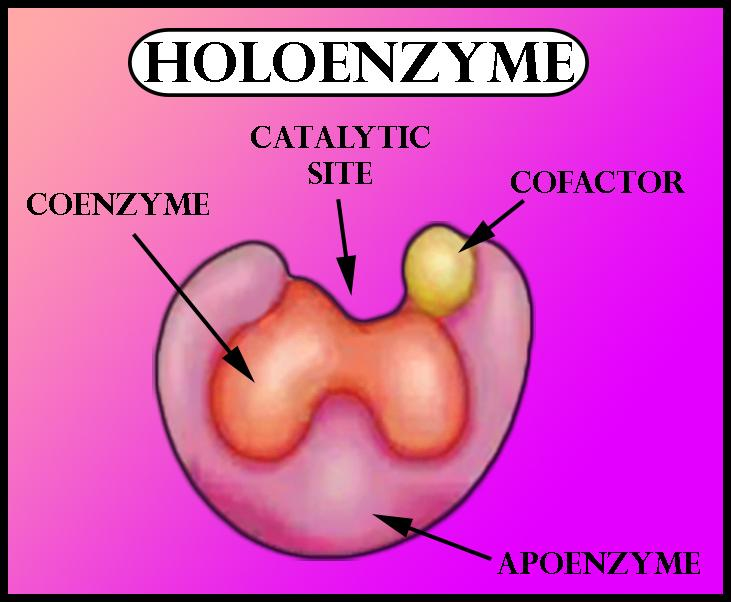Answer
394.2k+ views
Hint: This kind of enzyme is a catalytically active enzyme that includes an inactive enzyme and a non-polypeptide group of cofactors. Typical examples of such kinds of enzymes are DNA polymerase and RNA polymerase which contain multiple protein subunits.
Complete answer:
The enzyme, which combines with the non-protein part to form a functional enzyme is known as the holoenzyme.
Let's begin the explanation by first understanding what an enzyme is.
A highly specific biomolecule possessing the ability to catalyze biochemical reactions is called an ‘enzyme.’ Enzymes are proteinaceous in nature. They can be simple proteins, for example, lactase, maltase, sucrase, and malate isomerase. But sometimes they can be present in the form of conjugated proteins. Such enzymes are known as ‘holoenzymes’. Holoenzyme consists of a protein part and a non-protein part. The protein part of the enzyme is called ‘apoenzyme’ while the non-protein part is called ‘prosthetic group’ (cofactor). One such example is aminotransferase + pyridoxal phosphate.
Additional Information: -FAD and FMN are examples of coenzymes that contain riboflavin as a prosthetic group. Rate of enzyme activity increases in the presence of coenzymes.
-The cofactor is non-proteinaceous in nature. It can be metal ions or other inorganic ions.
-Prosthetic groups can be organic such as lipids, sugar, and vitamins, or inorganic such as metal ions, but they can never be composed of amino acids.
So, the correct answer is, ‘Holoenzyme.’

Note: -Coenzymes are a type of cofactor which are organic in nature. Examples of coenzymes are nicotinamide adenine dinucleotide (NAD) and ascorbic acid.
-The apoenzyme is often present in an inactive form. Binding with an organic or inorganic cofactor leads to its activation.
-Prosthetic groups are tightly bound, specific non-polypeptide units that are required for the biological functioning of some proteins.
Complete answer:
The enzyme, which combines with the non-protein part to form a functional enzyme is known as the holoenzyme.
Let's begin the explanation by first understanding what an enzyme is.
A highly specific biomolecule possessing the ability to catalyze biochemical reactions is called an ‘enzyme.’ Enzymes are proteinaceous in nature. They can be simple proteins, for example, lactase, maltase, sucrase, and malate isomerase. But sometimes they can be present in the form of conjugated proteins. Such enzymes are known as ‘holoenzymes’. Holoenzyme consists of a protein part and a non-protein part. The protein part of the enzyme is called ‘apoenzyme’ while the non-protein part is called ‘prosthetic group’ (cofactor). One such example is aminotransferase + pyridoxal phosphate.
Additional Information: -FAD and FMN are examples of coenzymes that contain riboflavin as a prosthetic group. Rate of enzyme activity increases in the presence of coenzymes.
-The cofactor is non-proteinaceous in nature. It can be metal ions or other inorganic ions.
-Prosthetic groups can be organic such as lipids, sugar, and vitamins, or inorganic such as metal ions, but they can never be composed of amino acids.
So, the correct answer is, ‘Holoenzyme.’

Note: -Coenzymes are a type of cofactor which are organic in nature. Examples of coenzymes are nicotinamide adenine dinucleotide (NAD) and ascorbic acid.
-The apoenzyme is often present in an inactive form. Binding with an organic or inorganic cofactor leads to its activation.
-Prosthetic groups are tightly bound, specific non-polypeptide units that are required for the biological functioning of some proteins.
Recently Updated Pages
Basicity of sulphurous acid and sulphuric acid are

What is the stopping potential when the metal with class 12 physics JEE_Main

The momentum of a photon is 2 times 10 16gm cmsec Its class 12 physics JEE_Main

Using the following information to help you answer class 12 chemistry CBSE

Which of the following would not be a valid reason class 11 biology CBSE

Why should electric field lines never cross each other class 12 physics CBSE

Trending doubts
Difference Between Plant Cell and Animal Cell

Difference between Prokaryotic cell and Eukaryotic class 11 biology CBSE

Fill the blanks with the suitable prepositions 1 The class 9 english CBSE

Fill the blanks with proper collective nouns 1 A of class 10 english CBSE

Change the following sentences into negative and interrogative class 10 english CBSE

Select the word that is correctly spelled a Twelveth class 10 english CBSE

What organs are located on the left side of your body class 11 biology CBSE

What is the z value for a 90 95 and 99 percent confidence class 11 maths CBSE

Give 10 examples for herbs , shrubs , climbers , creepers



